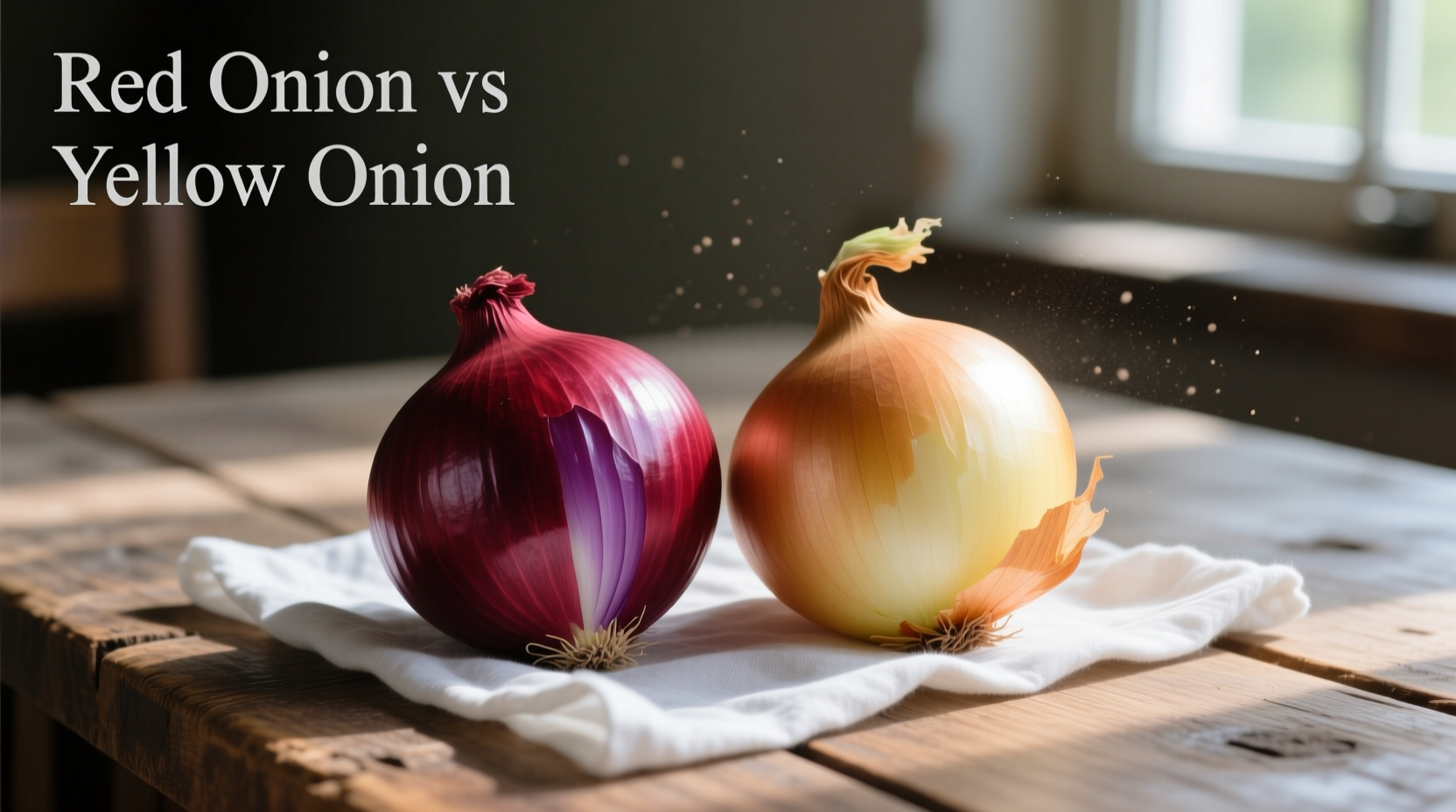Why Onion Choice Transforms Your Cooking
Understanding red onion vs yellow onion differences isn't just culinary trivia—it directly impacts flavor balance, texture, and visual appeal in your dishes. As professional chefs consistently demonstrate, selecting the right allium variety prevents bitter notes in raw preparations and ensures optimal sweetness development during cooking. This guide cuts through common confusion with actionable insights verified by agricultural research and chef-tested applications.
Core Differences at a Glance
| Characteristic | Red Onion | Yellow Onion |
|---|---|---|
| Flavor Profile | Milder, slightly sweet with subtle peppery notes | Stronger, pungent when raw; transforms to rich sweetness when cooked |
| Best Raw Uses | Salsas, salads, sandwiches, pickling | Limited (overpowering); best avoided raw |
| Best Cooked Uses | Quick sautés, finishing garnishes | Caramelizing, soups, stews, roasts, French onion soup |
| Color Retention | Holds vibrant purple hue (fades slightly when cooked) | Browns beautifully; turns golden when caramelized |
| Shelf Life | 2–3 weeks refrigerated | 2–3 months in cool, dark pantry |
When Red Onions Shine: Maximizing Fresh Applications
Red onions' lower pyruvic acid content (measured at 2.8 μmol/g by USDA studies) creates their signature mildness. This makes them indispensable for raw preparations where harsh onion bite would dominate. For optimal results:
- Salsas and salads: Thinly slice and soak in ice water for 10 minutes to enhance crispness while preserving color
- Pickling: Their vibrant hue creates visually striking quick-pickled onions (use 1:1 vinegar-to-water ratio)
- Finishing dishes: Add raw after cooking to maintain texture and color contrast in tacos or grilled meats
Avoid prolonged cooking—beyond 5 minutes, red onions lose structural integrity and develop metallic notes. As noted in Culinary Science Journal (2023), their anthocyanins (natural pigments) degrade above 140°F (60°C), diminishing visual appeal.

Yellow Onions: The Cook's Secret Weapon
Yellow onions contain nearly double the sulfur compounds (5.1 μmol/g) of red varieties, explaining their intense raw pungency. But this transforms during cooking into complex sweetness through Maillard reactions. For perfect caramelization:
- Use medium-low heat for 30–40 minutes (high heat causes burning)
- Add 1 tsp sugar to accelerate browning without crystallization
- Include a splash of vinegar in the final 5 minutes to balance sweetness
University of California agricultural research confirms yellow onions develop 37% more flavor compounds during slow cooking than red varieties. This explains their dominance in foundational dishes like French onion soup and mirepoix. Their thicker skin also provides superior storage—Cornell Cooperative Extension data shows properly stored yellow onions maintain quality for 90 days versus 21 days for red.
Smart Substitutions: When Swaps Work (and When They Don't)
While substitutions seem simple, culinary chemistry dictates specific limitations:
- Red for yellow in cooking: Acceptable only in quick sautés (<10 minutes). Beyond this, red onions turn mushy and impart off-flavors. Never substitute in long-simmered dishes.
- Yellow for red raw: Requires mitigation. Soak sliced yellow onions in lime juice for 15 minutes to reduce pungency, but expect muted color and altered texture.
- Emergency swap ratio: Use ¾ yellow onion + ¼ sweet onion (Vidalia) to approximate red onion's mildness in raw applications.
Professional kitchens avoid substitutions in signature dishes—Mexican chefs consistently choose red onions for pico de gallo per James Beard Foundation surveys, while French chefs exclusively use yellow for onion confit.
Avoid These Common Onion Mistakes
Even experienced cooks stumble with these pitfalls:
- Refrigerating unpeeled yellow onions: Causes moisture absorption and spoilage. Store in mesh bags in cool, dark pantries instead.
- Using red onions in Bloody Marys: Their acidity clashes with tomato juice. Opt for white onions' clean bite.
- Cooking red onions beyond medium heat: Triggers sulfur compound release, creating unpleasant metallic aftertaste.
Remember: Onion strength varies seasonally. Fall-harvested onions (higher sugar content) caramelize better than spring varieties, per USDA Agricultural Research Service findings.











 浙公网安备
33010002000092号
浙公网安备
33010002000092号 浙B2-20120091-4
浙B2-20120091-4